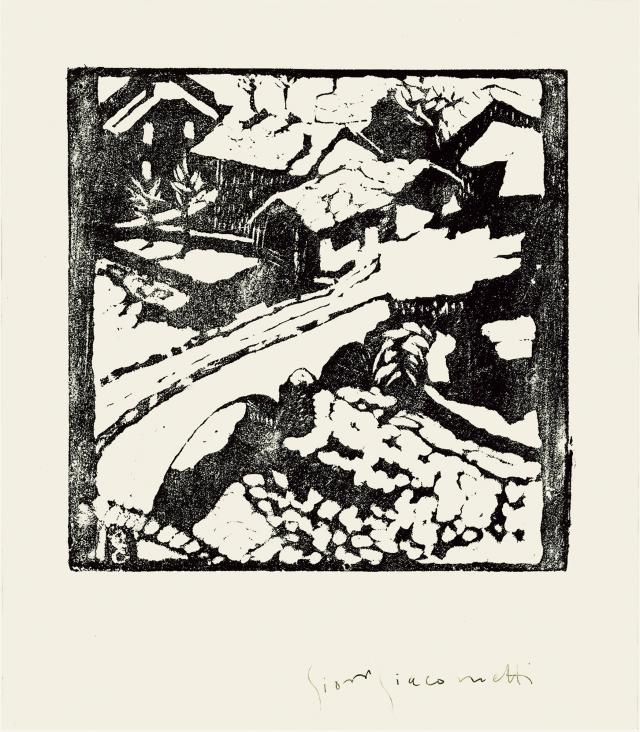Giovanni Giacometti’s woodcut engravings owe much to his friend Cuno Amiet, though even more to his continuing contacts with the Die Brücke group, which he first encountered in 1908. Except for Félix Vallotton, a precursor and pioneer of modern xylography, woodcut was still rarely practiced in the early years of the 20th century. Giacometti tries his hand at engraving in the late 1890s but works in the medium only sporadically.
His first woodcut dates from 1908: Mutter und Kind I, Annetta mit Bruno (Mother and Child I, Annetta with Bruno). This greeting card sent to friends features two faces emerging from a deep black background. The image depicts his wife, Annetta, holding in her arms their son Bruno. Sketched out in just a few lines, the faces are joined, the arms intertwined in a pose inherited from classic Italian models, as is often the case with Giacometti whenever he takes up the mother-and-child motif.
This initial attempt at woodcut would only be repeated a few years later, in 1911, with subjects drawn from his paintings. Thus Il Ponte al sole (Bridge in Sunlight) transforms the limpid atmosphere and dazzling colouring of his eponymous canvas from 1907 through the use of black surfaces lightened with areas of white. By reinterpreting his pictorial work in prints, Giacometti was looking to make it accessible to the general public and expand his audience.
Toeletta della sera III, Portrait Annetta Giacometti (Evening Toilet III, Portrait of Annetta Giacometti) is another example of this transposition. All that remains of the 1906 painting is the composition. Like a Renaissance Madonna, Annetta Giacometti is brushing her hair before a mirror, her head slightly bowed in a dreamy melancholic posture. The same year, with Knieder Mädchenakt von vorn, Ottilia (Nude Study of Seated Girl), the nude body of Ottilia Giacometti, bordered by black shadow and shown in a twisted pose, is rendered in quick angular tormented strokes that indicate the influence of Die Brücke’s expressionism.
For Inverno (Winter), Giacometti returns to an 1899 canvas that is still very much steeped in the symbolism of Giovanni Segantini. Three long female figures are crossing a snowy landscape, like mysterious shadows slipping over the white mass in a composition that is devoid of any perspectival illusion and pared down to the bare essentials.
His first woodcut dates from 1908: Mutter und Kind I, Annetta mit Bruno (Mother and Child I, Annetta with Bruno). This greeting card sent to friends features two faces emerging from a deep black background. The image depicts his wife, Annetta, holding in her arms their son Bruno. Sketched out in just a few lines, the faces are joined, the arms intertwined in a pose inherited from classic Italian models, as is often the case with Giacometti whenever he takes up the mother-and-child motif.
This initial attempt at woodcut would only be repeated a few years later, in 1911, with subjects drawn from his paintings. Thus Il Ponte al sole (Bridge in Sunlight) transforms the limpid atmosphere and dazzling colouring of his eponymous canvas from 1907 through the use of black surfaces lightened with areas of white. By reinterpreting his pictorial work in prints, Giacometti was looking to make it accessible to the general public and expand his audience.
Toeletta della sera III, Portrait Annetta Giacometti (Evening Toilet III, Portrait of Annetta Giacometti) is another example of this transposition. All that remains of the 1906 painting is the composition. Like a Renaissance Madonna, Annetta Giacometti is brushing her hair before a mirror, her head slightly bowed in a dreamy melancholic posture. The same year, with Knieder Mädchenakt von vorn, Ottilia (Nude Study of Seated Girl), the nude body of Ottilia Giacometti, bordered by black shadow and shown in a twisted pose, is rendered in quick angular tormented strokes that indicate the influence of Die Brücke’s expressionism.
For Inverno (Winter), Giacometti returns to an 1899 canvas that is still very much steeped in the symbolism of Giovanni Segantini. Three long female figures are crossing a snowy landscape, like mysterious shadows slipping over the white mass in a composition that is devoid of any perspectival illusion and pared down to the bare essentials.
